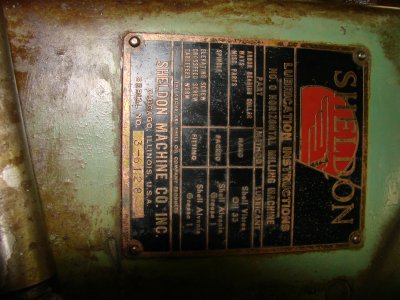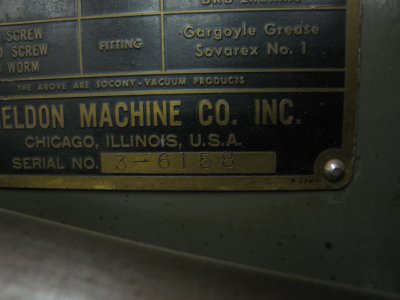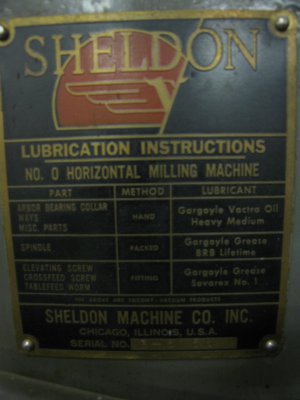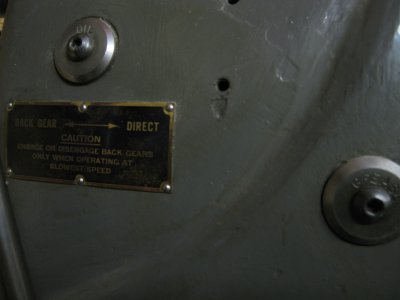-
Welcome back Guest! Did you know you can mentor other members here at H-M? If not, please check out our Relaunch of Hobby Machinist Mentoring Program!
You are using an out of date browser. It may not display this or other websites correctly.
You should upgrade or use an alternative browser.
You should upgrade or use an alternative browser.
Info on Sheldon Vernon horizontal mills
- Thread starter TomKro
- Start date
- Joined
- Nov 24, 2011
- Messages
- 84
Mike,
Who's got two phase power these days? I never would have expected to see that. The plugs on the side of my machine are in the same places as yours but look a little different than yours, kind of a button head hex, the back one says "oil" and the front one says "grease". I see yours has the grease fittings by the spindle bearings too. Glad you got the arbor out, did you get the Reeves drive thing figured out?
Tom,
Thanks for the lube info. I didn't get a manual with mine either. I found one for the older model, should print of a copy, would be better than nothing.
David,
I have a "newer manual" of sorts
I got the arbor out without damage and I'll be working on the Reeves drive sometime this week. I plan to remove the entire platform and "work it over." Meanwhile I've purchased a run capacitor and will try a wiring set-up which will, hopefully, allow me to run it on 230VAC 1PH. I'll keep you posted on this.
What is the serial # of your machine? Mine was made in 1959. Here is a photo of the Lube Plate:

Mike


I wonder if they remember each other, entirely possible that they were in the factory at the same time.
That motor is interesting. I have read that 2 phase power was common in the early days of alternating current, back in the days of Tesla/Westinghouse/Edison, but had no idea that it was still around. Hope you can get it working.
Thanks on the manual, I'll send you my email.

- Joined
- Jan 10, 2013
- Messages
- 176
Two phase power is still in use in parts of Philadelphia- a weird legacy from when power was first installed. Rail on the Northeast Corridor also still runs on 25 hz power because that's what the Pennsylvania Railroad used in the 1920's.
That motor is interesting. I have read that 2 phase power was common in the early days of alternating current, back in the days of Tesla/Westinghouse/Edison, but had no idea that it was still around. Hope you can get it working.
It is still used in a surprising number of industrial pockets in the northeast, mostly by customers with old equipment who don't want to change anything. The power companies provide it from their three phase distribution system by using a Scott-T transformer winding configuration. It's fairly easy to generate from a single phase home panel for a small motor using a capacitor - often called a static phase converter. There are some losses but it beats buying a new motor...
It is still used in a surprising number of industrial pockets in the northeast, mostly by customers with old equipment who don't want to change anything. The power companies provide it from their three phase distribution system by using a Scott-T transformer winding configuration. It's fairly easy to generate from a single phase home panel for a small motor using a capacitor - often called a static phase converter. There are some losses but it beats buying a new motor...
Ahhh, the light comes on!!! I am nothing even resembling an electrician, but from looking at the schematics I thought that a static converter was really just two phase power. It just didn't occur to me until I read this that a static converter was what he needed to run his motor. That's an easy fix, a $79 ebay thing.
- Joined
- Dec 8, 2013
- Messages
- 2,651
Ahhh, the light comes on!!! I am nothing even resembling an electrician, but from looking at the schematics I thought that a static converter was really just two phase power.
Sort of. The trouble is that the amount of phase shift and the current available from the shifted phase depends on both the value of the capacitor and the impedance of the load, so it really only works well for one motor at a time.
- Joined
- Nov 24, 2011
- Messages
- 84
Sort of. The trouble is that the amount of phase shift and the current available from the shifted phase depends on both the value of the capacitor and the impedance of the load, so it really only works well for one motor at a time.
Well, we'll soon know. I've ordered a 40MF capacitor and it's scheduled for delivery tomorrow. Will get together with "AAF Mike" and work-up a trial set-up. I'll keep you all posted.
Mike
Sort of. The trouble is that the amount of phase shift and the current available from the shifted phase depends on both the value of the capacitor and the impedance of the load, so it really only works well for one motor at a time.
Absolutely! Keeping in mind the dynamic impedance changes with chip load as well... But it only has to be matched to the Sheldon mill motor. We'll probably have to fiddle with the size of the capacitor - the 40uF was a guesstimate for the 1 hp motor. It's probably a little high, but we might get motor starting without a start cap as a bonus this way. It will depends on the inertia and internal friction of the rotated mass. I've suggested that Mike find an old lawn mower starting rope, but he seems to be having doubts about that...


